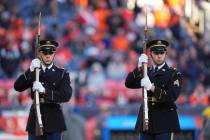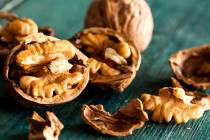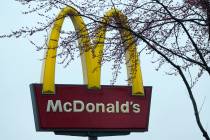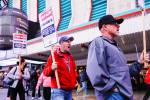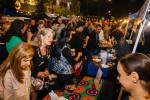UNLV exhibit looks at Culinary Union influence
Henry Shepherd held onto his old union dues books. They’re relics of his nearly 45-year career in Las Vegas hospitality, and a throwback to days when union members went down to the union hall to pay dues and have their books stamped.
Shepherd, whose career recalls the heyday of Sammy Davis Jr. and Wayne Newton, worked in the back of the Sands hotel-casino washing dishes until desegregation gave him a shot at apprentice bartending. His dues-paying, book-stamping union hall visits were a chance to rub shoulders with other members, including the union’s president, vice president and secretary-treasurer.
“It was more like a meet-and-greet,” says Shepherd, now a member of UNITE HERE Bartenders Local 165. “Chitchat. Tell everybody it’s going to be OK.”
Shepherd contributed his dues books to “Line in the Sand: The People, Power and Progress of the Culinary Union.” The UNLV Public History program’s student-curated exhibit will run from Friday through April 1 in the first-floor gallery of UNLV’s Lied Library.
The exhibit represents a massive collaboration, not only between UNLV and the 55,000-member Culinary Local 226. The collaboration also extends cross-departmentally, within UNLV, and with the Nevada State Museum.
The Culinary union is, according to its digital strategy director, Bethany Khan, the largest local of UNITE HERE, which represents hospitality workers in the United States and Canada. Khan calls the exhibit a “greatest hits” collection that includes buttons, pins, T-shirts, oral histories and photographs related to nearly 80 years of Culinary history in Las Vegas.
Themes ranging from labor and race to immigration and LGBT issues are all at play in the exhibit. All have been paramount for a union that claims to be the largest immigrant organization in Nevada, with a health insurance program that led the way in the state, covering same-sex domestic partners.
The organization’s members speak more than 40 languages, representing workers from more than 160 countries. Fifty-one percent are Latinos, and more than half are women. Among them are kitchen workers, housekeepers, cocktail waitresses and cooks.
The exhibit documents highs, lows and sacrifices embedded in the organization’s history, including the citywide strike in 1984 and the Frontier strike in the 1990s, says the union’s secretary-treasurer Geoconda Arguello Kline.
Those strikes were “key in this fight we have had for the standard of living in the city,” she says.
Hannah Robinson, the exhibit’s graduate student curator, shows archival items on display at Lied Library. A “Support Frontier Strikers” button reads “Desert Solidarity: Our Line in the Sand.” T-shirts commemorate the more recent struggle with Station Casinos. Yet another T-shirt reads: “We Struck. We Stuck. Scabs Suck. I Was a Jailbird for Culinary Local 226 ’84.”
Then there’s the entity privately dubbed by some as the “Gray Lady,” a statue about 10 feet tall, approximating Lady Liberty. She earned her place in Union history by appearing at pickets and holding banners from 1992 to 1998, Khan says. For years, she’s sat idly outside at the Culinary union, plaster flaking in the desert sun. But the students who’ve pulled the exhibit together have been trying to patch her up while maintaining historical integrity.
Besides an estimated 35 objects, the exhibit includes 10 oral histories offering stories from protesters, and a round-table discussion with five Las Vegas bartenders. More interviews may be added to the collection later, says Claytee White, director of the Oral History Research Center at UNLV Libraries. White conducted all of the interviews, with some help from a graduate student.
“I really didn’t know much about Las Vegas at all,” says Robinson, who moved here from Washington state more than a year ago. “I’ve been able to learn about economic history, tourist history, and at the same time, labor history in the Southwest, which I absolutely knew nothing about before this project.”
But even locals might be surprised by the unexpected turns the exhibit documents, White says, such as the transformation of civil disobedience over decades.
“Back in the 1970s and ’80s, the police department would round up the strikers and put them onto a bus with windows closed and the people handcuffed,” she says. “We’re talking about midsummer. So the bus would turn into a heat box.”
Compare that, she adds, with more recent events at The Cosmopolitan of Las Vegas, where arrangements were made between the police department and strikers, so police knew what time the strikers would hit the street. Strikers knew that they would be handcuffed, sometimes so loosely that handcuffs fell off.
Deirdre Clemente, associate director of UNLV’s public history program, has led the charge, with 13 students, in a graduate-level colloquium on public history. Clemente, a clothing historian, served as a consultant for the 2013 movie version of “The Great Gatsby,” which starred Leonardo DiCaprio.
In hot pursuit of what she describes as “material culture,” she and her students gradually shaped the exhibit, drawing on expertise from the UNLV photography department and the Nevada State Museum, among others. Along the way, they’ve delved into local history with experts Michael Green and Eugene Moehring.
This past spring, the class launched a treasure hunt in a hot tin shed in the union’s parking lot, where relics from the union’s past had been sitting, gathering dust. Sweating students began cataloging the remnants of Culinary’s history, wrapping and storing them in archival boxes for preservation.
The hunt also extended into union offices and closets, with those associated with the union’s history also making contributions.
Clemente says the exhibit was born about two years ago of an emerging campuswide interest in labor studies. Along with that came an interest in developing a relationship with the Culinary union. At the center of it all was Christopher Hudgins, dean of UNLV’s College of Liberal Arts. Hudgins’ interest in the union goes back to 1993.
More recently, student internships at the union and the possibility of expanded archive collections in UNLV’s library system, with help from the union, have been points of discussion, Hudgins says.
“(The exhibit) gives a picture of just how central the Culinary union has been to developing our, I think, number-one-in-the-country service industry,” he says.
Arguello Kline came from Nicaragua and moved to Las Vegas in 1983, starting as a guest room attendant. For her, the exhibit is important in demonstrating the sacrifices workers made over the years to create a decent living standard.
“They don’t make money if they’re outside,” she says. “And in the summer, you walk outside. But if they didn’t do it, Las Vegas wouldn’t be the city it is now.”
White says, “This exhibit shows that we are one of the most powerful labor union cities in the country. We have been that for a long time. People don’t know that.”
Preview
What: "Line in the Sand: The People, Power, and Progress of the Culinary Union"
When: during regular operating hours, Friday through April 1
Where: Lied Library at UNLV, 4505 S. Maryland Parkway
Admission: Free (702-895-2255; www.UNLVPublicHistory.com/Culinary)






















